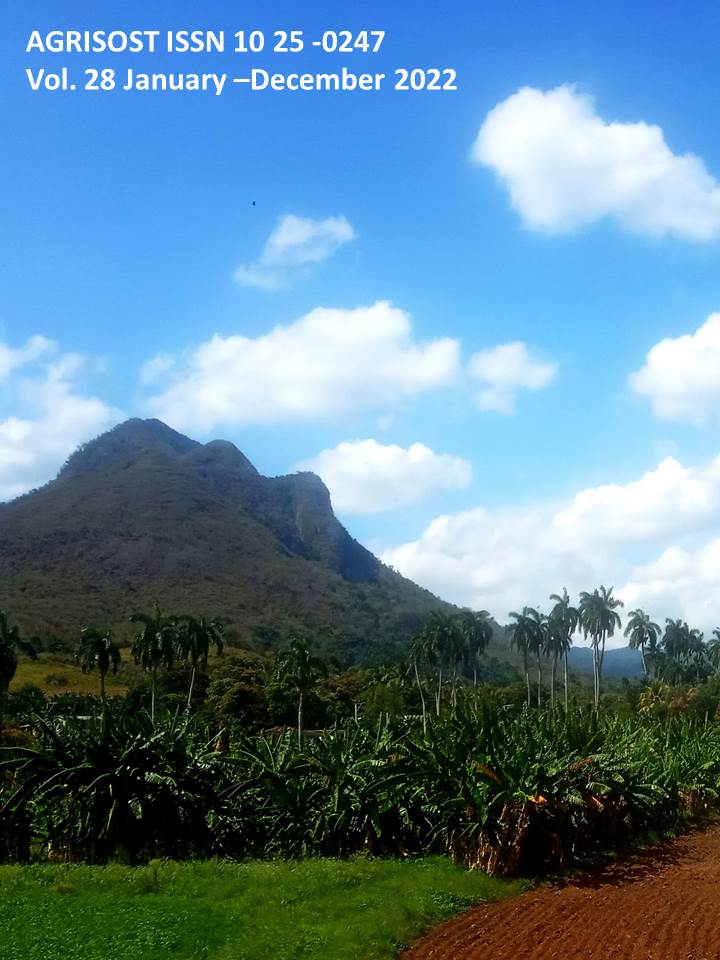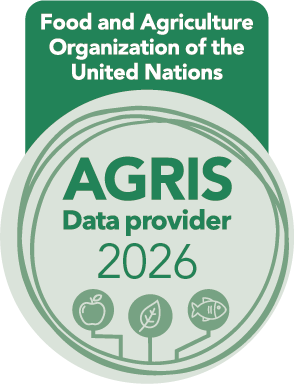Potentialities of Wheat-Associated Bacterial Diversity as Growth Promoter of Wheat (Triticum aestivum L.)
DOI:
https://doi.org/10.5281/zenodo.7867963Palabras clave:
gramineous, microorganisms, biofertilizerResumen
Context: Some microorganisms stimulate plant growth. Accordingly, this study focused on wheat-associated bacterial diversity to select promising strains for farming.
Aim: To select promising strains that stimulate wheat growth, with a wheat-associated bacterial diversity.
Methods: The bacteria from the rhizosphere and interior of wheat plants were isolated (cultivars Cuba C 204 and I 399). Its nitrogen fixing potential was characterized in vitro, along with the microorganisms’ capacity to solubilize nutrients and antagonistic activity against Fusarium sp and Curvularia lunata. The strains were introduced in wheat seeds under semi-controlled conditions, and their effect on growth indicators were evaluated.
Results: Several microorganisms were isolated, such as four strains classified as Bacillus, four Azotobacter, and two of them as Azospirillum, depending on their morphology. All the microorganisms were capable of fixing the nitrogen from the atmosphere. Except for one strain, they solubilized nutrients, and showed antagonistic activity against F. graminearum, F. chlamydosporum, F. oxysporum, and C. lunata. Its inoculation in wheat demonstrated the feasibility of using bacterial diversity associated with the plant species to stimulate 21-day-old plantlet growth from cultivars Cuba C 204 and I 399.
Conclusions: There is a microbial diversity associated with the wheat plants with a potential to stimulate in vitro and in vivo growth. Some of these microorganisms have promising features to obtain a new product for cropping, which can increase yields in the Cuban conditions.
Descargas
Referencias
Alves, C.J., Arf, O., Ramos, A.F., Galindo, F.S., Nogueira, L.M., & Rodrigues, R.A.F. (2017). Irrigated wheat subjected to inoculation with Azospirillum brasilense and nitrogen doses as top-dressing. Revista Brasileira de Engenharia Agrícola e Ambiental, 21 (8), 537-542. https://doi.org/10.1590/1807-1929/agriambi.v21n8p537-542
Andrade, F. C., Fernandes, F., Oliveira, A., Rondina, A.B.L., Hungria, M., & Nogueira, M.A. (2021). Enrichment of organic compost with beneficial microorganisms and yield performance of corn and wheat. Brazilian Journal of Agricultural and Environmental Engineering, 25 (5), 332-339. http://dx.doi.org/10.1590/1807-1929/agriambi.v25n5p332-339
Baldani, I., Massena Reis, V., Videira, S., & Boddey, L. H. (2014). The art of isolating nitrogen-fixing bacteria from non-leguminous plants using N-free semi-solid media: a practical guide for microbiologists. Plant Soil, 384, 413–431 (2014). https://doi.org/10.1007/s11104-014-2186-6
Brenner, D.J., Krieg, N.R., & Stanley, J. T. (Eds.) (2005). Volume 2: The Proteobacteria. Part B. The Ganmaproteobacteria. En Bergey’s Manual os Sytematic Bacteriology. (pp. 384-402). Springer US.
Cavalcante, V.A., & Dobereiner, J. (1988). A new acid-tolerant nitrogen-fixing bacterium associated with sugarcane. Plant Soil, 108, 23–31. https://doi.org/10.1007/BF02370096
Cesa-Luna, C., Baez, A., Quintero-Hernández, V., de La Cruz, J., Castañeda-Antonio, M. D., & Muñoz-Rojas, J. (2020). Importancia de compuestos antimicrobianos producidos por bacterias benéficas en el biocontrol de fitopatógenos. Acta Biológica Colombiana, 25(1), 140-154. http://dx.doi.org/10.15446/abc.v25n1.76867
Chinakwe, E.C., Ibekwe, V.I., Nwogwugwu, U.N., Onyemekara, N.N., Ofoegbu, J., Mike-Anosike, E., Emeakaraoha, M., Adeleye, S., & Chinakwe P.O. (2019). Microbial population changes in the rhizosphere of tomato Solanum lycopersicum varieties during early growth in greenhouse. Malaysian Journal of Sustainable Agriculture (MJSA), 3(1), 23-27. http://doi.org/10.26480/mjsa.01.2019.23.27
de la Fé, Y., Díaz de la Osa, A., Restrepo, G. M., Diván- Baldani V. L., & Hernández, A. (2015). Diversidad de bacterias diazotróficas asociativas potencialmente eficientes en cultivos de importancia económica. Revista Cubana de Ciencias Biológicas, 4(1), 17-26. http://www.rccb.uh.cu/index.php/RCCB/article/view/85
Departamento de Suelos y Fertilizantes. (2018). Manual Práctico para el Uso de Bioproductos. Órgano Central del Ministerio de la Agricultura.
Grobelak, A., Napora, A., & Kacprzak, M. (2014). The impact of plant growth promoting bacteria (PGPB) on the development of phytopathogenic fungi. Folia Biologica et Oecologica, 10, 107-112. http://doi.org/10.2478/fobio-2014-0008
González, H., & Fuentes, N. (2017). Mecanismo de acción de cinco microorganismos promotores de crecimiento vegetal. Revista de Ciencias Agrarias, 34(1), 17-31. http://dx.doi.org/10.22267/rcia.173401.60
Harrigan, W.F., & Mc Cance, M. (1968). Métodos de Laboratorio en Microbiología. Ed. Academia.
Hernández, A., Pérez, J.M., Bosch, D. & Castro, N. (2015). Clasificación de los suelos de Cuba. Instituto Nacional de Ciencias Agrícolas, Instituto de Suelos. Ediciones INCA.
Hernández, J. J., Morales, P.G., Rodríguez, R.F., & Sánchez, J.M. (2015). Inoculación de Burkholderia cepacia y Gluconacetobacter diazotrophicus sobre la fenología y biomasa de Triticum aestivum var. Nana F2007 a 50% de fertilizante nitrogenado. Scientia Agropecuaria, 6(1), 7–16. https://doi.org/10.17268/sci.agropecu.2015.01.01
Hernández, J.L., Cubillos, J.G., & Milian, P.E. (2012). Aislamiento de cepas de Rhizobium spp., asociados a dos leguminosas forrajeras en el Centro Biotecnológico del Caribe. Revista Colombiana de Microbiología Tropical, 2(2), 51-62. https://www.researchgate.net/publication/298069900_Aislamiento_de_cepas_de_Rhizobium_spp_asociados_a_dos_leguminosas_forrajeras_en_el_Centro_Biotecnologico_del_Caribe_Isolation_of_Rhizobium_spp_associated_two_forage_leguminous_in_the_Caribbean_Biotech
Madigan, M.T., Bender, K.S., Buckley, D.H., Sattley, W. M., & Sthal, D.A. (2018). Brock Biology of Microorganisms. (15th edition). Published by Pearson.
Mahmoud, A.F. (2016). Genetic variation and biological control of Fusarium graminearum isolated from wheat in Assiut-Egypt. Plant Pathology Journal, 32(2),145-156. https://doi.org/10.5423/PPJ.OA.09.2015.0201
Martínez, V. R., López, M., Brossard, F. M., Tejeda, G. G., Pereira, A. H., Parra, Z. C., Rodríguez, S. J., & Alba, A. (2006). Procedimientos para el estudio y fabricación de Biofertilizantes Bacterianos. Ed. INIA.
Martínez, S., Gómez-Kosky, R., Rodríguez, G., Veitia, N., Saucedo, O., & Gil, V. (2016). Caracterización morfoagronómica de plantas de sorgo granífero variedad CIAP 132R-5 regeneradas vía embriogénesis somática en condiciones de campo. Centro Agrícola, 43(3), 73-79. http://cagricola.uclv.edu.cu/descargas/pdf/V43-Numero_3/cag09316.pdf
Pedraza, L. A., López, C. E., & Uribe-Vélez, D. (2020). Mecanismos de acción de Bacillus spp. (Bacillaceae) contra microorganismos fitopátogenos durante su interacción con planta. Acta Biológica Colombiana, 25(1), 112-125. http://dx.doi.org/10.15446/abc.v25n1.75045
Pérez-Pazos, J.V., & Sánchez, D.B. (2017). Caracterización y efecto de Azotobacter, Azospirillum y Pseudomonas asociadas a Ipomoea Batatas del Caribe Colombiano. Revista Colombiana de Biotecnología, 19(2), 35-46. https://doi.org/10.15446/rev.colomb.biote.v19n2.69471
Piña, J., García, V., Herrera, H., & Flores, J. A. (2016). Valoración de cepas silvestres de Azospirillum sp. y Gluconacetobacter sp. como promotoras de crecimiento vegetal. Revista Mexicana de Ciencias Agrícolas, 7(7), 1613-1623. http://www.scielo.org.mx/pdf/remexca/v7n7/2007-0934-remexca-7-07-1613.pdf
Rojas, M. M., Sánchez, D., Rosales, K., & Lugo, D. (2017). Antagonismo de Bacillus frente a hongos fitopatógenos de cultivos hortícolas. Revista de Protección Vegetal, 32(2), 1-9. http://scielo.sld.cu/scielo.php?pid=S1010-27522017000200005&script=sci_arttext&tlng=pt
Rojas, M. M., Tejera, B., Bosh, D.M., Ríos, Y., Rodríguez, J., & Heydrich, M. (2016). Potentialities of Bacillus strains for promoting growth in maize (Zea mays L.) Cuban Journal of Agricultural Science, 50(3), 485-496. http://scielo.sld.cu/scielo.php?script=sci_arttext&pid=S2079-34802016000300016
Ruiz-Sánchez, E., Mejía-Bautista, M.Á., Serrato-Díaz-Serrato, A., Reyes-Ramírez, A., Estrada-Girón, Y., & Valencia-Botín, A.J. (2016). Actividad antifungica e identificacion molecular de cepas nativas de Bacillus subtilis. Agrociencia, 50, 133-148. http://www.scielo.org.mx/pdf/agro/v50n2/1405-3195-agro-50-02-00133.pdf
Saldaña, J.M. (2017). Aislamiento e identificación de cepas nativas de Rhizobium phaseoli de Suelo de la Presa de la Juventud de Marín, Nuevo León. Revista Iberoamericana de Producción Académica y Gestión Educativa, 4(7). https://www.pag.org.mx/index.php/PAG/article/view/659/826
Toledo-Hernández, E., Peña-Chora, G., Toribio-Jiménez, J., Romero-Ramírez, Y., Bolaños-Dircio, A., Velázquez-del Valle, M. G., Hernández-Lauzardo, A.N., León-Rodríguez, R., & Vero, S. (2021). Isolated rhizobacteria of Jatropha curcas L.: antagonistic activity of phytopathogens and plant growth promoter. Revista Chapingo Serie Ciencias Forestales y del Ambiente, 27(2), 181-198. https://doi.org/10.5154/r.rchscfa.2020.04.029
Vega-Celedón, P., Canchignia, H., González, M., & Seeger, M. (2016). Biosíntesis de ácido indol 3-acético y promoción del crecimiento de plantas por bacterias. Cultivos Tropicales, 37 (No. especial), 33-37. http://dx.doi.org/10.13140/RG.2.1.5158.3609
Villarreal-Delgado, M.F., Villa-Rodríguez, E.D., Cira-Chávez, L.A., Estrada-Alvarado, M.I., Parra-Cota, F.I., & de los Santos-Villalobos, S. (2017). The genus Bacillus as a biological control agent and its implications in the agri-cultural biosecurity. Revista Mexicana de Fitopatología, 36(1), 95-130. https://doi.org/10.18781/R.MEX.FIT.1706-5
Vital, L., Cruz, M.A., Fernández, S., & Mendoza, A. (2015). Diversidad bacteriana en raíces de maíz híbrido convencional y genéticamente modificado. ФYТОN. Revista Internacional de Botánica Experimental, 84, 233-243. http://www.scielo.org.ar/pdf/phyton/v84n1/v84n1a30.pdf
Yadav, A. N. (2017). Agriculturally Important Micro biomes: Biodiversity and Multifarious PGP Atributes for Amelioration of Diverse Abiotic Stresses in Crops for Sustainable Agriculture. Biomedical Journal of Scientific and Technical Research, 1(4),1- 4. https://doi.org/10.26717/BJSTR.2017.01.000321
Zahid, M., Kaleem, M., Hameed, S., & Rahim, N. (2015). Isolation and identification of indigenous plant growth promoting rhizobacteria from Himalayan region of Kashmir and their effect on improving growth and nutrient contents of maize (Zea mays L.). Front. Microbiol., 6, 207, 1-10. https://doi.org/10.3389/fmicb.2015.00207
Descargas
Publicado
Número
Sección
Licencia
Derechos de autor 2022 Yoania Ríos Rocafull, Marisel Ortega García, Janet Rodríguez Sánchez, Bernardo Dibut Álvarez

Esta obra está bajo una licencia internacional Creative Commons Atribución-NoComercial-SinDerivadas 4.0.
Usted es libre de:
- Compartir — copiar y redistribuir el material en cualquier medio o formato
- La licenciante no puede revocar estas libertades en tanto usted siga los términos de la licencia
Bajo los siguientes términos:
- Atribución — Usted debe dar crédito de manera adecuada , brindar un enlace a la licencia, e indicar si se han realizado cambios . Puede hacerlo en cualquier forma razonable, pero no de forma tal que sugiera que usted o su uso tienen el apoyo de la licenciante.
- NoComercial — Usted no puede hacer uso del material con propósitos comerciales .
- SinDerivadas — Si remezcla, transforma o crea a partir del material, no podrá distribuir el material modificado.







